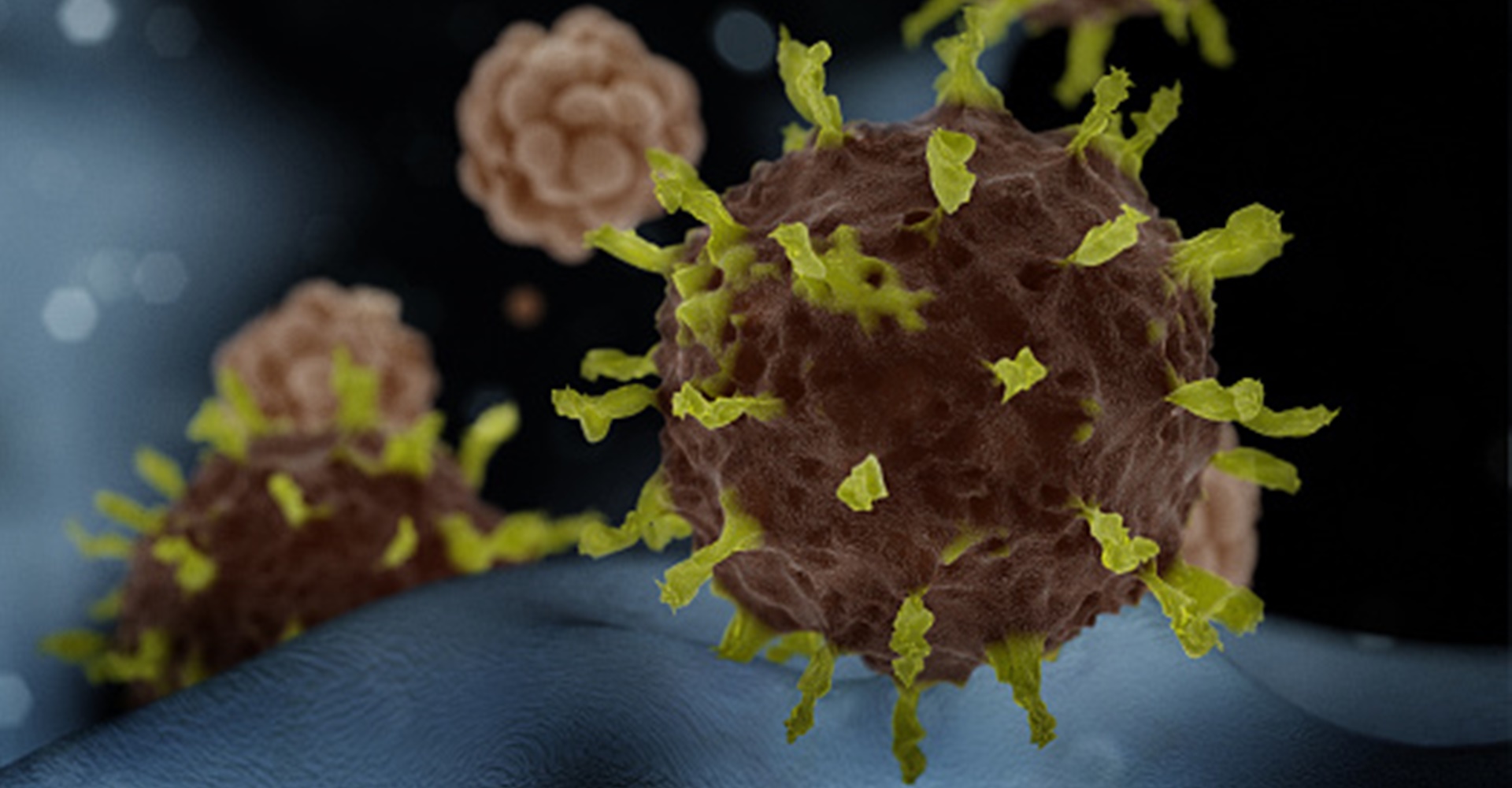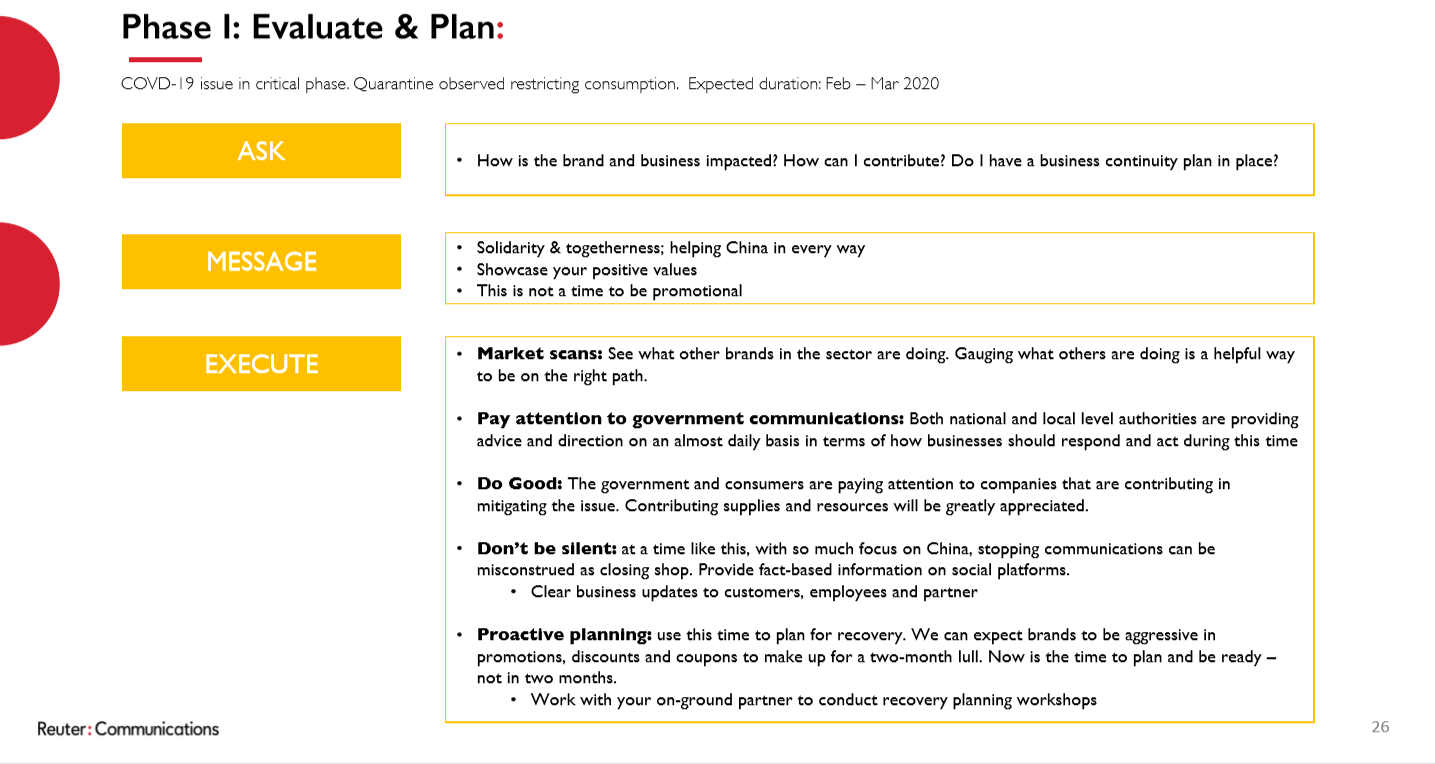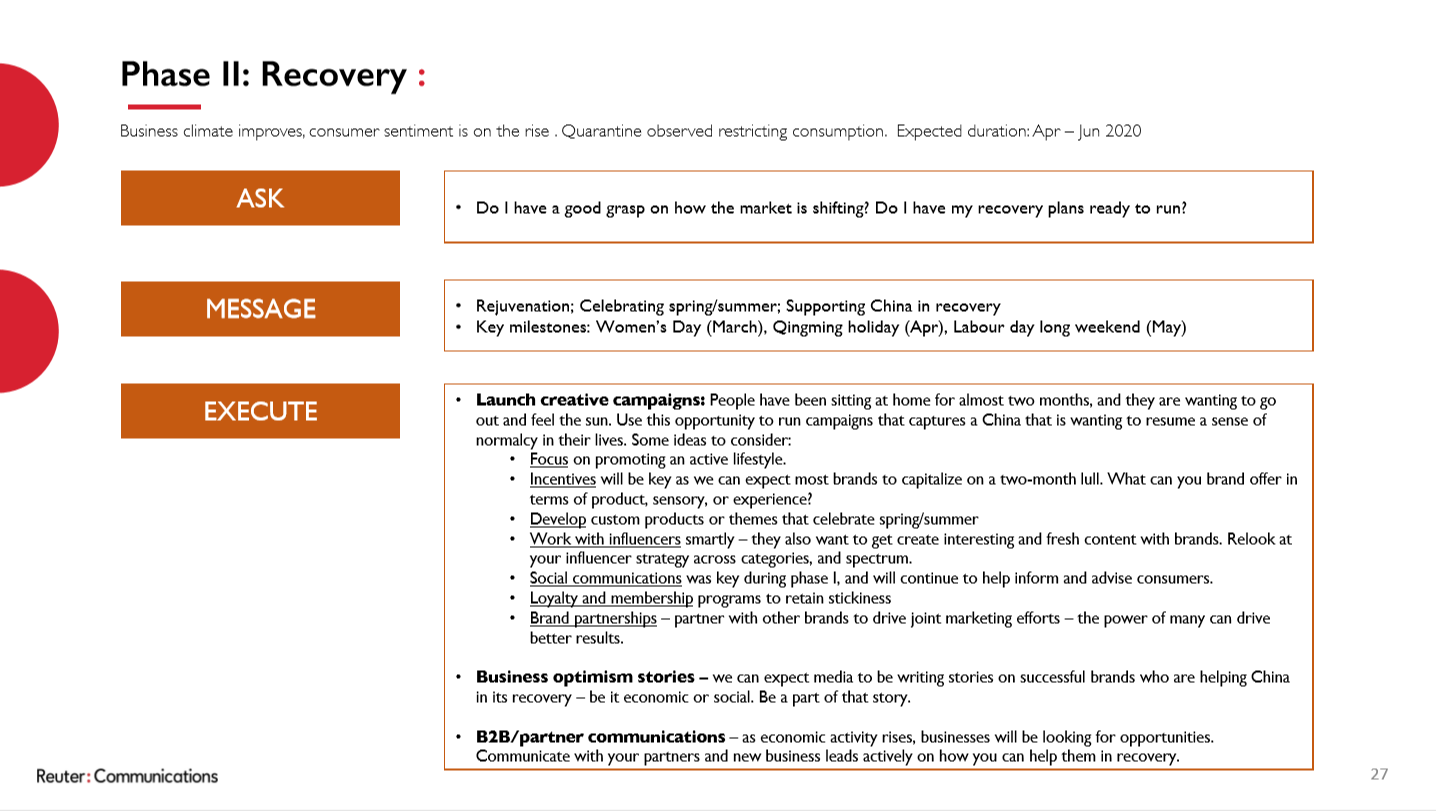The coronavirus, just given a formal name by the World Health Organization (COVID-19) yesterday, has been dominating news headlines in China and around the world. For brand marketers, there are two significant questions: how to respond, if at all, during the crisis. And, looking ahead, what changes in consumer behaviour to anticipate as a result of a prolonged lockdown. A look back at the events of the severe acute respiratory syndrome (SARS) in 2003 offers food for thought.
That fateful year could be marked as the year of e-commerce’s emergence in mainland China, when the crisis provided an unexpected turning point for faster e-commerce adoption. Many tech veterans remember how the severe outbreak forced the citizens of China to be stuck indoors, threatening the future of JD.com (then still called Jingdong, a brick-and-mortar shop which sold hard disk drives and electronics in Beijing).
Recognising this as an opportunity to pivot the business, CEO Richard Liu revamped his physical storefront into an e-commerce model within a year. The country’s long confinement in 2003 also boosted Alibaba, then resembling more a business-to-business directory. Spurred by then-CEO Jack Ma, the core team brainstormed a new idea that would eventually evolve into Taobao, the company’s business-to-consumer e-commerce powerhouse.
In Alibaba: The House that Jack Ma Built, a book by Duncan Clark, it is argued that SARS also spurred digital mobile telephony, with increased texting revenue for China Mobile, Sina, Sohu, and Netease. Some say, there is always opportunity in calamity.
Coronavirus and behavioural science
By Ashok Sethi, GM of Illuminera Institute
Behavioural science can not say much about the behaviour of the novel coronavirus. However, it can definitely shed some light on the behaviour of the people who valiantly face this threat. The behaviour change induced by the virus, of both individuals and institutions, is unprecedented. Perhaps never have the Chinese people displayed such homogeneity of behaviour – over as billion people staying put at home, almost one hundred percent use of the mask, diligent washing of hands and whatever else considered necessary to avoid the dreaded virus. Achieving behaviour change of this nature is every marketer’s dream and it would be worthwhile to analyze what we see from a behavioural science perspective.
Evolutionary fear of the unknown
Evolution has shaped our brains to be cautious. Our bold and intrepid ancestors did not last long enough to pass their genes to the next generations. But the relatively timid and cautious survived and successfully transmitted their genes. Fear of the unknown is built into our reptilian brains. The unknown virus, with its alarming expansion, inevitably makes us ultra-cautious. New brands need to overcome this inherent fear of the unknown. When confronted with a plethora of brands, the consumer tendency is to be cautious – they will rather gravitate to the known and familiar, than the new and mysterious. A marketer’s task is to shake the consumers out of their unconscious thinking and make them take notice (or engage their System 2 brain, as behavioural economists would say).
Availability bias
Over 700,000 die in China every month (as one will expect in a large population). While most die of old age, many die prematurely of disease and accidents. Rationally, we should be much more concerned about diabetes and coronary disease than about the coronavirus. 60,000 a month die of accidents and injuries alone. However, currently, all our fears and concerns focus on 2019-nCoV. The behaviour scientists call this the availability bias. Marketing also often makes use of the availability bias to catch consumer attention. A blitzkrieg of advertising and heavy media presence could make the consumer think the brand to be much more popular than it actually is.
Respect for authority and social herding
Humans have a natural respect for authority. Particularly when faced with the unknown, we readily follow the authoritative figures of the government, medical profession, and communities. The Chinese remain cooped in their homes, not just because of fear of infection, but also of deference to authority. Additionally, our natural tendency to do what everyone else is doing also contributes to the uniformity of behaviour. Marketers often use the authority cues in their communication (“used by doctors”, “made with German technology”). Social herding is, of course, a key pillar of online celebrity marketing.
Power of stories
Stories have strong sway over our minds. Media often plays stories of people who won a million-dollar lottery, or stumbled across a similar unique fate, and never about the millions of lottery buyers who never won a dime. Media today is bursting with stories of a 44-year-old Wang or 65-year-old Chen, who unwittingly caught the virus. We also need to hear stories of people who recovered from the virus or did not get the infection despite facing similar risks. Positive stories will calm the mind and help us make better decisions to return to normalcy. Brands show varying success in harnessing the power of stories. Many spin engaging stories around themselves and their users, powerfully interweaving the two. Whereas others merely rely on facts and claims of superiority, which often go unnoticed and unheralded.
Probability weighting
Research shows that we tend to overestimate small probabilities. With just a few hundred cases in cities like Shanghai and Beijing, though the probability of catching the virus is extremely low, we tend to exaggerate the risk, and the threat looms large in our minds. Many industries exist on the strength of probability weighting. No one will buy a lottery if they did not exaggerate the infinitesimal chance of winning the jackpot. None will buy insurance if the fear of loss did not appear much bigger than the real chance of the disaster,
Hindsight bias
When the virus is dead and gone, the Chinese are again buzzing with their customary optimism and energy, and the world again welcoming them and their money, many who worried to death during the outbreak, will merrily succumb to the hindsight bias and proclaim with a broad smile, “I always knew it will be short-lived and will leave no long term impact on our lives!” Marketers need to design their strategies on the basis of insights gained from understanding consumer behaviour and identifying the real drivers – else brand review meetings of below-budget performance will surely be dominated by a liberal airing of hindsight bias.
When SARS happened, there was no reference point for businesses and brands when it comes to navigating around a high-profile health crisis that incurred human costs and strained supply chains across the globe due to an economy that is much more interconnected with China. But today, 17 years later, it is still possible to take a leaf out of the SARS book as the current situation plays out.
What to do in the immediate present:
Adjust media investments based on moods and expectations of consumers
During the outbreak, maintaining brand credibility with public interest ads should be prioritised over any sales promotions, product-driven communications and awareness-building efforts, said Dentsu Aegis Network (DAN) in an advisory update, recommending the media mix below:
- Minimise: OOH (cinema, airport, railway)
- Increase: Digital (official media, short video, social, news and info sites)
- Maintain: OTT, Online video (news and dramas)
The estimated drop in China adspend for the whole of 2020 is less than one percent, according to the January update of Zenith’s Adforecast 2020 below. While there may be roadblocks for market researchers and ad testers who require fieldwork, there shouldn’t be a major impact on online media planning & buying, PR or social media monitoring. OOH advertising will suffer for obvious reasons, in the short run.
As China eventually heads into a post-epidemic recovery phase, the timing yet unknown, GroupM is forecasting an emphasis on content marketing as consumers get used to the format while being homebound.
Prepare for accelerated online FMCG sales in both essential and impulse categories
FMCG spending through e-commerce channels in China grew almost seven times as fast as the sector overall in 2019 – a trend that the coronavirus outbreak is likely to accelerate in early 2020. Latest data from Kantar Worldpanel shows that FMCG spending in urban China increased 5.3% last year, but e-commerce in FMCG spending leapt 36.2%.
The research firm expects that the current coronavirus outbreak “will further strengthen the position of e-commerce and delivery service, especially in fresh foods, as consumers try to avoid traditional wet markets”.
Chinese consumers in top-tier cities were already accustomed to shopping online for many products and services. Kantar notes that “O2O delivery has already become an integrated part of the retail offer” for both small and big players, so the quality of service, as well as the digital experience, will become differentiators in the future. China’s elderly generation, who were resistant to e-commerce, will become more accepting of the ways of buying goods over the web, predicted Jason Yu, general manager of Kantar Worldpanel China.
At the same time, impulse categories like alcohol or dairy items are likely to benefit while consumers obtain their necessities like rice and noodles online, said Yu.
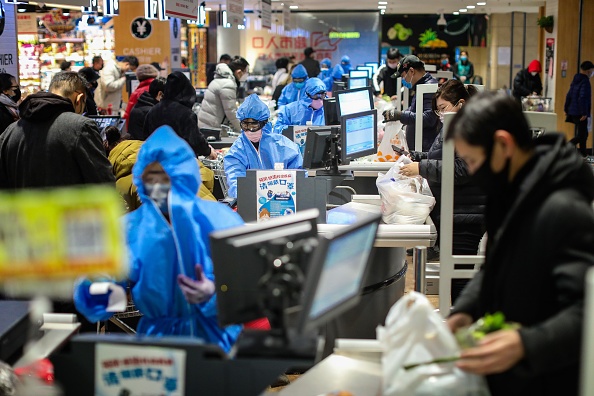
Cashiers wearing protective masks at a supermarket in Shenyang in China’s northeastern Liaoning province. (Photo by STR/AFP via Getty Images)
Be helpful: how brands deal with the crisis now may shape consumer views beyond
Brands using their market position and prowess to be helpful during the coronavirus outbreak will leave an impression. So far, there have been two types of interventions. The first type is serving the public with specific services offered free of charge by tech and media owners who have the most advantage in terms of reach. Alibaba launched a global B2B sourcing platform to connect medical-goods suppliers with frontline medical personnel directly, and Tencent set up a WeChat function to collect tipoffs and suggestions from the general public in order to prevent misinformation and improve efficiencies.
Starbucks China was one of the first non-endemic Western brands to get in front of the issue with (literally) hands-on tips on maintaining health and cleanliness.
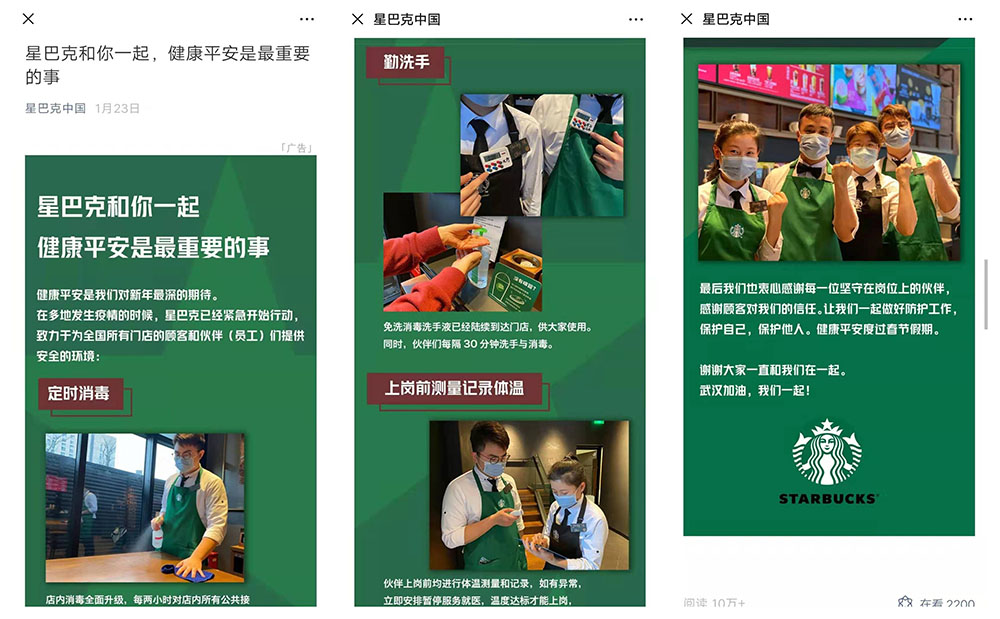
Another type of intervention is mitigating the impact of coronavirus interruptions on vulnerable small- to medium-sized enterprises (SMEs), as Hema did when it hired more than 2000 idle employees from restaurants that had suspended their operations to alleviate their cost pressures. Separately, Ant Financial’s online commercial lender MyBank reduced interest rates for business loans by 10% for 1.8 million small business owners in Hubei, the epicentre of the outbreak.
In reality, brands could be actually spending more money maintaining their supply chains and service levels, since provinces like Shanghai, Jiangsu, Zhejiang, and Guangdong have formally required organisations (except those involved in providing basic services and those involved in combating the spread of the virus) to pay salaries to staff not working during this period or pay double wages to staff having to work during the furlough.
“This demonstrates deep care to a brand’s community and I think this is important to show that we are all connected with the crisis,” stated Kantar’s Yu.
“Your ultimate goal should not be just how to make money; you should aim to create value for consumers. At this point in time, it’s not about what the company can do to remain profitable, but what the company can do for consumers to satisfy their needs,” according to Hugo Chan, chief innovation officer at WE Marketing Group and managing partner of WE Digital.
Where appropriate, demonstrate brand purpose and brand care (carefully)
Most brands have been smart to stay on the side-lines with traditional commerce-driven marketing for now, at least until the outbreak is under control.
A word of caution: even brands that provide hygiene products should not do any type of marketing that could be seen as self-serving.
“You shouldn’t be going, ‘hey, buy more of my masks, buy more of my hand sanitisers’. You shouldn’t appear to be profiting off misery,” said Prophet senior partner and Asia regional lead Jay Milliken. The only appropriate marketing that could be done is around public service (sharing factual information around infection prevention) or CSR (tangible support of those affected by the outbreak), he added.
DAN recommends only products in highly-relevant categories should engage in advertising right now, such as disinfection products, medicine, insurance, food, health products, fitness and office equipment. In the meantime, travel and luxury brands should not be visible.
Brands need to tread a fine line, with the risk of being misinterpreted by consumers, especially right now. “In the past, we’ve seen lots of companies that have had the best, brilliant intentions but the intentions were poorly executed. This is not the time to be beating your own chest. This is the time to be a good corporate citizen to contribute to the public good, and not to be ‘seen’ as ‘a super good company’,” said Milliken. “Execute it wrongly and it could turn into a landmine.”
If unsure, keep the messaging simple, guided Nick Cakebread, managing partner of Reuter Communications. Show that your thoughts are with Chinese people, rather than try and emphasise a lot of details (such as how long the brand has been in China, for example). This is not the time to educate people on your brand’s key messages. For donations, revealing the amount donated and where it is going, maintain simplicity, rather than overly stating the finances of the donation, the PR firm said, detailing a staggered recovery plan.
For example, true to its brand values, online healthcare platform Pingan Good Doctor set up an antivirus command centre with access to free online consultations by volunteer respiratory physicians.
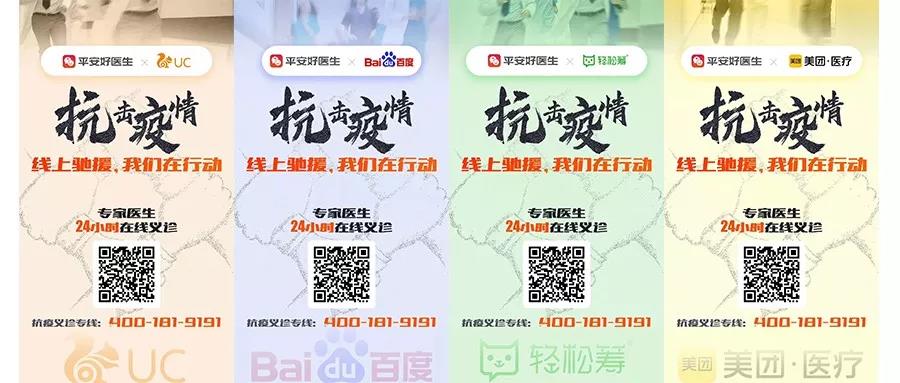
And no, a ‘Coronavirus versus Corona Beer’ campaign is not appropriate
Google Trends data shows people have been accidentally linking the virus to the beer, as search volume for ‘corona beer virus’, ‘beer virus’, and ‘beer coronavirus’ have been growing since late January 2020. The potentially harmful mix-up was shrugged off by the brand’s distributor in the US. Maggie Bowman, senior communications director of Constellation Brands had told CBS that “consumers, by and large, understand there’s no linkage between the virus and our beer business”.
While there have been recommendations for Corona to enhance its brand reputation by providing genuine help to victims of the virus without any branding tie-in (for example, donating proceeds of beer sales to relief efforts), the current state of cynicism in the world will ferment a damaging downside to any such strategy.
“It’s a ‘third rail’ issue. Even if the brand says ‘hey we donated like $10 million or 100 million RMB, that can come across as self-serving. I think it’s best to stay away from marketing around this.” The downside is three times as big as the upside, said Milliken, “just because this isn’t a static situation but very fluid and changing all the time”.
The downside was probably overlooked when Fitzgerald’s Irish Bar in Bunbury, Australia, wanted to hand out free face masks for a party named “sickest night of the year” touting AU$6 Coronas all night, and “(sort of) promises [they] aren’t contaminated”.
“There’s been a LOT of talk about Corona and to be honest it’s made us pretty thirsty…” the bar captioned a flyer on Facebook that displayed a Corona beer bottle wearing a face mask. “We’ve heard Corona is pretty popular at the moment. We’re not sure why though, it’s just beer isn’t it?”

Another bar, House on Hood in Hamilton, New Zealand, was condemned by the public for offering deals on Corona beer “while the pandemic lasts”. “Let’s be honest, there are worse things you can catch in Hamilton,” a second promotion read.
And let’s be honest, there are better things for marketers to do than spread ignorance and gallows humour.
What to know for the near future:
A spike in online content consumption may outlast the crisis period
While Moody’s signalled challenges to China’s discretionary consumer spending on transportation, retail, tourism, the winners are obviously players within the sphere of online consumption. Apart from e-commerce, these include the fields of distance learning, gaming, live streaming, virtual entertainment, telemedicine/health-tech/insurance, and remote working/enterprise communication software – though the rate of change in consumer behaviour will vary.
“Given the anxiety and fear around any form of social interaction, I think that live streaming, gaming, and virtual entertainment will see the biggest benefits in the short term, as these businesses are pretty optimised to operate through a prolonged period of self-quarantine,” Milliken told WARC.
Live streaming content will see a surge in availability as more people have time on their hands to produce and consume it. Chinese tech firm ByteDance has also stepped in to fuel this trend, offering to pay at least RMB630m (US$90.8m) for new movie Lost in Russia to be streamed over its various video platforms, instead of cinemas (forced to close due to the virus). This may set a precedent for both the Chinese film industry and the marketing sector to relook at the model of paid entertainment, with the implications for monetisation pointing to IP-related merchandise and (more) ads.
DAN numbers showed the daily active user (DAU) count of video apps in China increased by 42% compared with Chinese New Year in 2019, while time spent on OTT platforms spiked 20%. As online consumption endures, online user acquisition will take precedence in the first half of 2020, and digital marketers will have their mettle tested as they try to break through the funnel and produce practical results, or risk disappearing in the expected saturation of ads. We already see education and fitness providers delivering free broadcasts of online classes to acquire new users and retain old ones. Fitness app Keep live-streamed home workout classes and saw its revenue surging 15% last week, reported Reuters.
A permanent change in purchase behaviour is not guaranteed – but marketers need to be alert to an expedited shift to e-commerce
As consumers continue to shun bricks-and-mortar stores for fear of infection, data on Tmall sales from e-commerce analytics company Yimian (now a sister company of WARC) show a high willingness to order online, when comparing the same period year-on-year. Chinese consumers started to stock up masks one day before 20 Jan 2020 when respiratory expert Prof Zhong Nanshan confirmed infections of 14 medical workers, as well as the risk of human-to-human transmission.
| Category (Chi) | Category (Eng) | Sales (1.19-2.9 2019) | Sales (1.19-2.9 2020) | Growth% |
| 口罩(器械) | Masks (surgical) | 587,177 | 107,210,420 | 18159% |
| 医用手套 | Gloves (surgical) | 147,785 | 18,149,012 | 12181% |
| 衣物除菌剂 | Clothing sanitiser | 939,311 | 31,568,504 | 3261% |
| 护目镜 | Goggles | 312,751 | 10,313,615 | 3198% |
| 维生素E+C | Vitamin E + C | 181,199 | 5,927,136 | 3171% |
| 防护服 | Protective suit | 152,565 | 4,773,188 | 3029% |
| 维生素E/小麦胚芽油 | Wheat germ oil | 119,925 | 3,699,633 | 2985% |
| 口罩 (其它) | Masks (others) | 5,126,283 | 145,893,682 | 2746% |
| 皮肤消毒护理 | Skin disinfectant | 2,377,253 | 65,924,177 | 2673% |
| 防护面具 | Masks (face) | 436,104 | 11,281,875 | 2487% |
| 棉签棉球(器械) | Cotton swabs | 556,857 | 14,021,530 | 2418% |
Source: Yimian Data
When it comes to food, from 24 Jan to 2 Feb 2020, nationwide sales of produce on JD increased by 215% compared with the same period last year, with nearly 15,000 tons of fresh products sold. Sales of pork, beef, mutton, poultry and eggs all exceeded 400% year-on-year growth. Vegetable sales increased by nearly 450% compared with the same period last year.
Kantar Worldpanel China reviewed historical retail data in 15 Chinese cities back in the SARS period from 2002 to 2003 to shed light on how consumer behaviour may change with the n-COV epidemic. Naturally, the instant food, household cleaning, and personal hygiene categories showed noticeable sales increases in the 12-week period ending May 2003.

Food and beverage or groceries have traditionally low e-commerce penetration rates (compared to apparel and cosmetics). The crisis may spur e-commerce in this sector, but the evidence from SARS is mixed.
TNS concluded in March 2004 that while SARS had obviously had an impact on consumers, it did not fuel an increase in overall online shopping amongst the shopaholic Chinese even after the virus was contained. In a 2004 Esomar paper, internet shopping numbers in Hong Kong fell back to pre-SARS levels once the early days of the pandemic had subsided, with only online banking increasing in usage.
It is difficult to use the SARS outbreak as a direct comparison with the coronavirus since the nature of e-commerce is fundamentally different now than it was in 2003, pointed out Milliken. Many more consumers use e-commerce on a regular basis today compared with 17 years ago. Without factors like the supply chain logistics, payment infrastructure, user-friendly platforms, and most importantly, trust, e-commerce would not have taken off. People now have the confidence that if they buy something online, it will get delivered in a timely manner, virus or not.
Buying behaviour changes are dependent on habit formation – a longer-term endeavour – but Chinese consumers are certainly getting schooled fast in habits like thorough handwashing, and for their own sake, they want to adopt good habits, as Yu put it to WARC.
New digital services introduced to cope with the crisis may have longevity
WeChat, which already has one of the highest app penetration rates in China, recently added a new ‘Health’ segment to its Wallet sub-menu that includes the ability to track real-time epidemic data of every province in China.
WeChat Work, the enterprise communication app from Tencent also released a set of new features explicitly aimed at facilitating remote work, such as conference calls of up to 300 people, forms to collate information about staff whereabouts during this critical period.
These moves expand WeChat’s portfolio of services on the back of netizens consuming more digital content and utilising more functions within adjacent environments. The current situation provided the company the right moment to introduce these features in the hope that continued use will result in sustainable user stickiness.
warc.com / balkantimes.press
Napomena o autorskim pravima: Dozvoljeno preuzimanje sadržaja isključivo uz navođenje linka prema stranici našeg portala sa koje je sadržaj preuzet. Stavovi izraženi u ovom tekstu autorovi su i ne odražavaju nužno uredničku politiku The Balkantimes Press.
Copyright Notice: It is allowed to download the content only by providing a link to the page of our portal from which the content was downloaded. The views expressed in this text are those of the authors and do not necessarily reflect the editorial policies of The Balkantimes Press.

